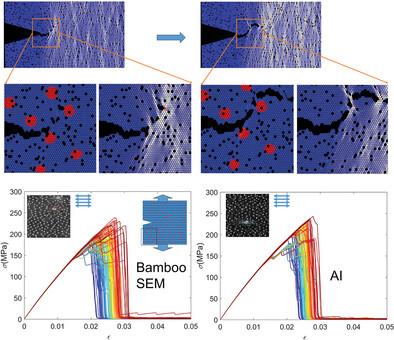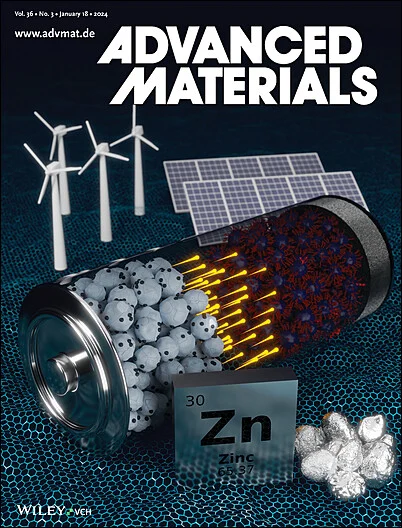竹表皮结构-力学关系与人工智能启发复合材料设计
IF 27.4
1区 材料科学
Q1 CHEMISTRY, MULTIDISCIPLINARY
引用次数: 0
摘要
竹材以其强度高、重量轻、成本低等特点在工程上得到了广泛的应用。它的最外层表皮光滑致密,含有纤维素、二氧化硅颗粒和气孔,起到水和机械屏障的作用。最近的实验研究表明,该层具有比其他内部区域更高的机械强度。尽管如此,其机制尚不清楚,特别是低二氧化硅浓度(10%)如何有效地增强层并防止内部纤维分裂。本文将理论分析与实验成像和3D打印相结合,研究二氧化硅颗粒的分布对复合材料力学的影响。竹皮中硅颗粒的各向异性偏分布函数比随机分布的颗粒具有更高的韧性(>10%)。受竹表皮的启发,开发了一种生成式人工智能(AI)模型来生成颗粒增强复合材料。除了视觉上的相似性外,生成模型的破坏过程和断裂韧性也与实际的竹表皮完全一致。这项工作揭示了竹表皮的微观力学。这表明,生成式人工智能可以帮助设计复杂结构的生物启发复合材料,这种复合材料不能用简单的构建块统一表示,也不能围绕局部边界进行优化。它扩展了颗粒增强复合材料的设计空间,增强了韧性模量,为机械可靠性至关重要的行业提供了优势。本文章由计算机程序翻译,如有差异,请以英文原文为准。

The Structure‐Mechanics Relationship of Bamboo‐Epidermis and Inspired Composite Design by Artificial Intelligence
Bamboo culm has been widely used in engineering for its high strength, lightweight, and low cost. Its outermost epidermis is a smooth and dense layer that contains cellulose, silica particles, and stomata and acts as a water and mechanical barrier. Recent experimental studies have shown that the layer has a higher mechanical strength than other inside regions. Still, the mechanism is unclear, especially for how the low silica concentration (<10%) can effectively reinforce the layer and prevent the inner fibers from splitting. Here, theoretical analysis is combined with experimental imaging and 3D printing to investigate the effect of the distribution of silica particles on composite mechanics. The anisotropic partial distribution function of silica particles in bamboo skin yields higher toughness (>10%) than randomly distributed particles. A generative artificial intelligence (AI) model inspired by bamboo epidermis is developed to generate particle‐reinforced composites. Besides the visual similarity, it is found that the samples by the generative model show failure processes and fracture toughness identical to the actual bamboo epidermis. This work reveals the micromechanics of the bamboo epidermis. It illustrates that generative AI can help design bio‐inspired composites of a complex structure that cannot be uniformly represented by a simple building block or optimized around local boundaries. It expands the design space of particle‐reinforced composites for enhanced toughness modulus, offering advantages in industries where mechanical reliability is critical.
求助全文
通过发布文献求助,成功后即可免费获取论文全文。
去求助
来源期刊

Advanced Materials
工程技术-材料科学:综合
CiteScore
43.00
自引率
4.10%
发文量
2182
审稿时长
2 months
期刊介绍:
Advanced Materials, one of the world's most prestigious journals and the foundation of the Advanced portfolio, is the home of choice for best-in-class materials science for more than 30 years. Following this fast-growing and interdisciplinary field, we are considering and publishing the most important discoveries on any and all materials from materials scientists, chemists, physicists, engineers as well as health and life scientists and bringing you the latest results and trends in modern materials-related research every week.
 求助内容:
求助内容: 应助结果提醒方式:
应助结果提醒方式:


